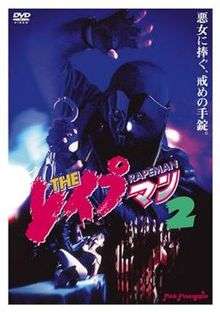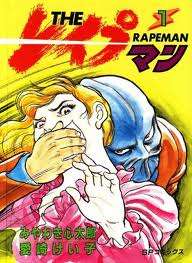The Rapeman
| The Rapeman | |
|
Cover of the first manga volume | |
| THE レイプマン (The Reipuman) | |
|---|---|
| Genre | Erotic |
| Manga | |
| Written by | Shintaro Miyawaki |
| Published by | LEED Publishing |
| Demographic | Seinen |
| Magazine | Lead Comic |
| Original run | 1985 – 1992 |
| Volumes | 13 |
| Live-action film | |
| Directed by | Takao Nagaishi |
| Written by | Jun Kojō |
| Studio | Pink Pineapple |
| Released | September 22, 1993 |
| Live-action film | |
| The Rapeman 2 | |
| Directed by | Takao Nagaishi |
| Written by | Jun Kojō |
| Studio | Pink Pineapple |
| Released | March 11, 1994 |
| Live-action film | |
| The Rapeman 3 | |
| Directed by | Takao Nagaishi |
| Written by | Jun Kojō |
| Studio | Pink Pineapple |
| Released | March 11, 1994 |
| Live-action film | |
| The Rapeman 4 | |
| Directed by | Takao Nagaishi |
| Written by | Hitoshi Ogiichi |
| Studio | Pink Pineapple |
| Released | September 30, 1994 |
| Original video animation | |
| The Rapeman Anime Version | |
| Directed by | Kinta Kunte |
| Produced by | Kotaro Ran |
| Written by | Kiyoshi Naito |
| Studio |
Pink Pineapple TEC |
| Released | October 28, 1994 |
| Episodes | 2 |
| Live-action film | |
| The Rapeman 5 | |
| Directed by | Takao Nagaishi |
| Written by | Jun Kojō |
| Studio | Pink Pineapple |
| Released | March 31, 1995 |
| Live-action film | |
| The Rapeman 6 | |
| Directed by | Takao Nagaishi |
| Written by | Jun Kojō |
| Studio | Pink Pineapple |
| Released | March 31, 1995 |
| Live-action film | |
| The Rapeman 7 | |
| Directed by | Takao Nagaishi |
| Written by | Jun Kojō |
| Studio | Pink Pineapple |
| Released | December 1, 1995 |
| Live-action film | |
| Ōedo Rapeman | |
| Directed by | Naoki Uesugi |
| Written by | Tomo Suzuki, Mitsuo Sakai |
| Studio | Pink Pineapple |
| Released | July 26, 1996 |
| Live-action film | |
| Ōedo Rapeman: Join Shokeijin | |
| Directed by | Naoki Uesugi |
| Written by | Tomo Suzuki, Mitsuo Sakai |
| Studio | Pink Pineapple |
| Released | November 1, 1996 |
The Rapeman (THE レイプマン) is a Japanese satirical–black comedy adult manga series. It is credited as being created and written by Keiko Aisaki (愛崎 けいこ Aisaki Keiko), and illustrated by Shintaro Miyawaki (みやわき 心太郎 Miyawaki Shintarō), and ran from 1985 to 1992. The series was discontinued after 13 volumes.
Pink Pineapple produced nine Rapeman live action feature films (including six sequels and two spin-off films), released between 1993 and 1996. The first seven were directed by Takao Nagaishi and the final two were directed by Naoki Uesugi. In their Japanese Cinema Encyclopedia: The Sex Films, the Weissers write that series director, Takao Nagaishi, took "a patently offensive premise and twisted it into a wickedly funny black-comedy for adults ... His camerawork is slick, and the music is hypnotic. Plus he has co-authored clever scripts with surprisingly intricate plotlines. And, most importantly, Nagaishi has taken the time to develop a group of characters who are actually very likable."[1]
A two-episode OVA was released in 1994, chronicling his exploits in the first volume of the manga. The Rapeman's garb is different in the anime version, as he is dressed in quasi-ninja gear.
Plot

The main character, Keisuke Iwasaki (岩崎 圭介 Iwasaki Keisuke), is a handsome and very muscular high school teacher by day and dispenses a surreal brand of "justice" at night as the Rapeman under the business "Rapeman Services", which is co-run with his uncle, a former surgeon. The business's motto is: "Righting wrongs through penetration."[2] Clients call on the Rapeman to handle cases such as the revenge of a jilted lover, forming parental bonds through a traumatic crisis, making disruptive co-workers more docile and other things of that nature. When engaged in his night trade, the Rapeman wears a black leather ski mask shaped like the head of a penis, but no trousers or underwear. In the middle of a rape, if the woman becomes unresponsive or expresses enjoyment, he uses special techniques such as "M69 Screwdriver" or "Infinite Loop" to apply more pain to the victim. Despite regretting some of the contracts he fulfills, he always completes the task.
Impact
The comic was mentioned by name in articles published in foreign publications in an attempt to delve into Japan's sex culture in the wake of the Waseda University Super Free "rape club" scandal.[3] A band called Rapeman credits the comic for the name the band chose. Frontman Steve Albini and drummer Rey Washam admitted their obsession with the character and that obsession carrying over to naming the band.[4]
On 4 October 1999, almost 3 years after the final release in the franchise, a fictional 14th volume of the series was featured in episode 3 "...Or Just Look Like One" of the crime drama TV series Law and Order: SVU. It was used by the prosecutor (who called upon detective Monique Jeffries as a witness) as a piece of evidence used against a young man accused of rape, whose father was also being charged as an accessory for bringing the comic into the house. The Rapeman is described as a high school student that turns into the alter-ego at night to take revenge on the girls at school that wronged him, rather than the adult "gun for hire" that Keisuke is.[5]
See also
- Hanzo the Razor – A 1970s exploitation movie set in Feudal Japan in which the protagonist uses rape to extract information.
References
- ↑ Weisser, Thomas; Yuko Mihara Weisser (1998). Japanese Cinema Encyclopedia: The Sex Films. Miami: Vital Books : Asian Cult Cinema Publications. pp. 341–342. ISBN 1-889288-52-7.
- ↑ Manchester Confidential: Manga-Chester
- ↑ Australian Broadcasting Corporation: Top Japanese university battles rape allegations
- ↑ Interview with Steve Albini (1994-05-06). "Steve discusses the naming of Big Black and Rapeman". Action Park, quoting Rock Names by Adam Dolgins. Retrieved 2007-05-21.
- ↑ Law And Order: SVU – "Or Just Look Like One" episode recap
External links
- IMDB page for the Rapeman live-action movie
- The Rapeman (anime) at Anime News Network's encyclopedia
